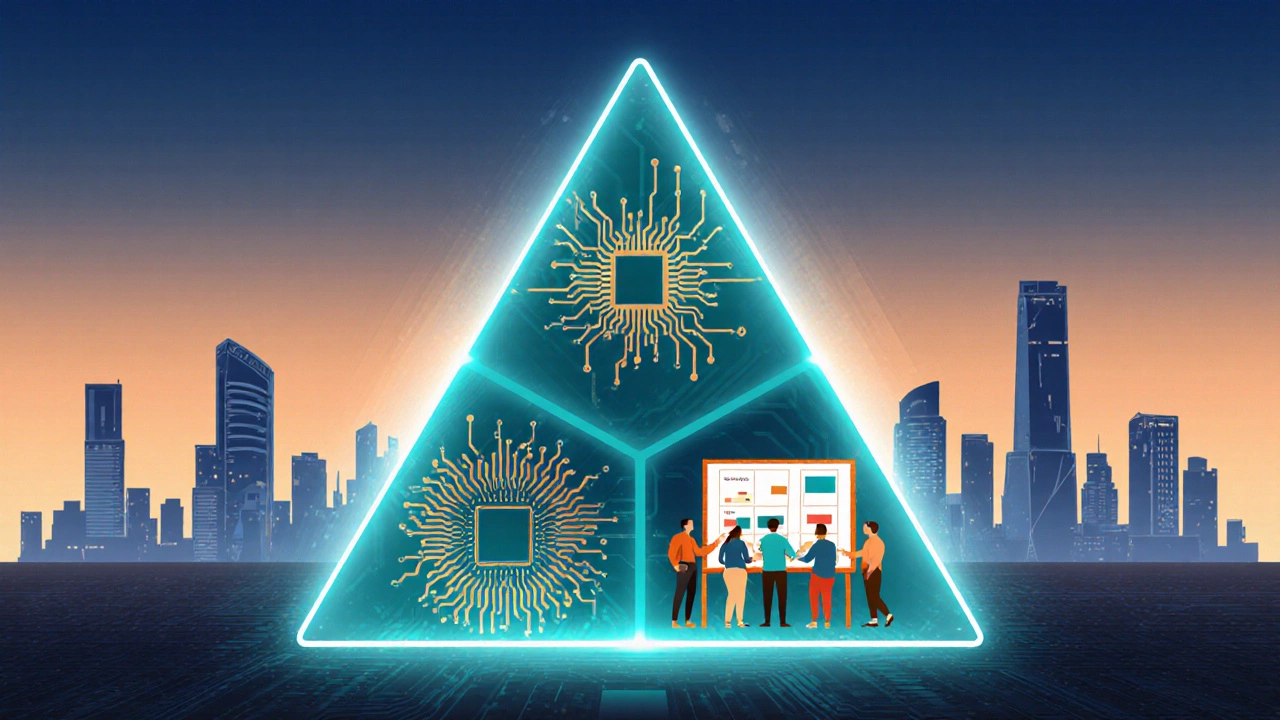Innovation Balance Calculator
Assess your innovation project's balance across the three core elements: Technology, Market, and Organization. Rate each on a scale of 1-5.
Technology
Market
Organization
Balance Score: /15
Recommendations
Ever wonder why some ideas turn into global breakthroughs while others fade away? The answer often boils down to three fundamental building blocks. Understanding these innovation elements lets governments, companies, and entrepreneurs design policies and strategies that actually work.
Defining Innovation
Innovation is the systematic conversion of ideas into market‑ready products, services, or processes that generate economic or social value. It isn’t just invention; it’s the whole journey from concept to impact.
The First Element: Technology
Technology is the set of tools, methods, and scientific knowledge that enable new capabilities. In 2024, AI‑augmented design tools cut prototype cycles by 40%, illustrating how a technological leap can accelerate the entire innovation pipeline.
- Attribute: Maturity - from lab‑scale (TRL 3) to commercial (TRL 9)
- Attribute: Adoption cost - ranges from open‑source (free) to proprietary licenses (up to $500,000 per year)
- Attribute: Impact speed - can shave weeks off development timelines
The Second Element: Market
Market is the ecosystem of customers, competitors, and distribution channels that determines whether an innovation finds a foothold. A breakthrough in clean‑energy storage, for example, only succeeds if utilities and automotive OEMs are ready to invest.
- Identify unmet needs through surveys and usage data.
- Validate price elasticity - how much are customers willing to pay?
- Map competitive landscape to spot differentiation opportunities.
The Third Element: Organization
Organization is the internal structure, culture, and processes that turn ideas into executable projects. Companies that embed cross‑functional squads and give autonomous budget authority see 30% faster time‑to‑market, according to a 2023 McKinsey survey.
- Structure: Agile squads vs. siloed departments
- Culture: Openness to failure (psychological safety score > 4/5)
- Process: Stage‑gate versus continuous delivery

How the Three Elements Interact
Think of the elements as a triangle. Move one vertex and the whole shape reshapes. For instance, a new Policy that funds early‑stage R&D lowers the technology cost, which in turn makes the market more receptive, encouraging organizations to allocate resources.
| Element | Key Attribute | Typical Metric | Primary Driver |
|---|---|---|---|
| Technology | Readiness Level | TRL 3‑9 | R&D investment |
| Market | Adoption Rate | % of target segment | Customer demand |
| Organization | Execution Speed | Time‑to‑market (months) | Process design |
Policy Levers to Strengthen Each Element
Governments can nudge the triangle with three targeted levers:
- Funding for Research & Development (R&D) - tax credits, grants, and matching funds raise technology readiness.
- Regulatory sandboxes - safe spaces where markets can test new products without full compliance burdens.
- Talent programs - scholarships and incubator support build the organizational muscle needed for execution.
Real‑World Example: Mobile Payments in India
The rapid rise of UPI (Unified Payments Interface) showcases the three‑element model perfectly.
- Technology: Open‑source API architecture enabled banks to integrate quickly.
- Market: A cash‑heavy economy created massive demand for low‑cost digital transactions.
- Organization: The National Payments Corporation of India (NPCI) coordinated banks, fintechs, and merchants under a unified governance framework.
Within two years, transaction volumes surpassed $1 trillion, and the ecosystem attracted $15 billion in private investment.

Practical Checklist for Leaders
- Audit your current technology stack - is it at least TRL 5 for core initiatives?
- Map market pain points - use NPS surveys and competitor gap analysis.
- Assess organizational agility - score teams on autonomy, funding speed, and learning loops.
- Align policy or funding requests with the specific element you need to boost.
Common Pitfalls and How to Avoid Them
Many innovation programs stumble because they focus on only one vertex.
- Tech‑first bias: Investing in cutting‑edge tech without market validation leads to dead‑end prototypes.
- Market‑only view: Chasing trends without a capable organization produces half‑baked rollouts.
- Organizational inertia: Rigid hierarchies slow down both tech adoption and market response.
The antidote is a balanced scorecard that measures progress across all three elements.
Next Steps for Policy Makers and Executives
- Set clear targets for each element (e.g., increase R&D intensity to 3% of GDP).
- Design incentive structures that reward cross‑element collaboration - joint R&D‑market pilots.
- Monitor a triadic KPI dashboard - technology readiness, market adoption, and execution speed.
- Iterate policies annually based on data, not assumptions.
What exactly is meant by ‘innovation’?
Innovation is the process of turning novel ideas into products, services, or processes that create measurable economic or social value.
Why are there only three elements?
The three‑element model captures the critical external and internal forces - technology, market demand, and organizational capability - that together determine whether an idea succeeds.
Can a policy focus on just one element?
Targeted policies work best when they address gaps in the triangle. For example, funding R&D without market incentives may produce advanced tech that never gets adopted.
How do I measure the ‘Organization’ element?
Key metrics include time‑to‑market, project success rate, and employee psychological‑safety scores. Agile squads and autonomous budgeting are common levers.
What are real‑world examples that illustrate all three elements?
India’s UPI system, as described above, showcases technology (open API), market (cash‑heavy consumers), and organization (NPCI coordination).



